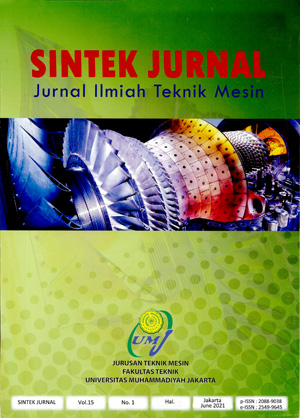ANALYSIS OF RTRTO60K16 PKX YARN PRODUCTION PROCESS WITH OBJECTIVE MATRIX (OMAX) METHOD
Main Article Content
Abstract
Article Details
- Articles published in SINTEK JURNAL are licensed under a Creative Commons Attribution-ShareAlike 4.0 International license. You are free to copy, transform, or redistribute articles for any lawful purpose in any medium, provided you give appropriate credit to the original author(s) and SINTEK JURNAL, link to the license, indicate if changes were made, and redistribute any derivative work under the same license.
- Copyright on articles is retained by the respective author(s), without restrictions. A non-exclusive license is granted to SINTEK JURNAL to publish the article and identify itself as its original publisher, along with the commercial right to include the article in a hardcopy issue for sale to libraries and individuals.
- By publishing in SINTEK JURNAL, authors grant any third party the right to use their article to the extent provided by the Creative Commons Attribution-ShareAlike 4.0 International license.
References
L. A. Silalahi, Rispianda, and Yuniar, “Usulan Strategi Peningkatan Produktivitas Berdasarkan Hasil Analisis Pengukuran Objective Matrix (OMAX) pada Departemen Produksi Transformer(Studi Kasus di PT. XYZ),” J. Online Inst. Teknol. Nas. Jur. Teh. Ind. No.03, vol. 02, no. Peningkatan Produktivitas, pp. 84–95, 2014.
D. Avianda, Y. Yuniati, and Yuniar, “Strategi Peningkatan Produktivitas di Lantai Produksi Menggunakan Metode Objective Matrix ( OMAX ),” J. Online Inst. Teknol. Nas., vol. 01, no. 04, pp. 202–213, 2014.
D. Surjasa, . A., and E. Irawati, “Pengukuran Kinerja Supply Chain Cv. X Berdasarkan Lima Proses Inti Model Supply Chain Operations Reference (Scor),” J. Ilm. Tek. Ind., vol. 5, no. 1, pp. 28–35, 2018, doi: 10.24912/jitiuntar.v5i1.1774.
P. P. Wardoyo and Y. Hadi, “Peningkatan Produktivitas Umkm Menggunakan Metode Objective Matrix,” J. Ilm. Tek. Ind., vol. 4, no. 1, pp. 1–8, 2017, doi: 10.24912/jitiuntar.v4i1.458.
M. Bahrudin and H. C. Wahyuni, “Pengukuran Produktivitas Kerja Karyawan pada Bagian Produksi dengan Menggunakan Metode Objective Matrix (OMAX) Dan Root Cause Analyze (RCA),” PROZIMA (Productivity, Optim. Manuf. Syst. Eng., vol. 1, no. 2, p. 116, 2018, doi: 10.21070/prozima.v1i2.1299.
M. M. Ulkhaq, D. R. Rasyida, P. Studi, T. Industri, F. Teknologi, and U. Diponegoro, “Aplikasi Seven Tools Dan Analisis 5W + 1H Untuk Mengurangi Cacat Produk Galon : Studi Kasus Di Pt . Berlina , Tbk .,” Unisbank Semarang, pp. 330–338, 2016.
H. Kartika, “Analisis Pengendalian Kualitas Produk CPE Film Dengan Metode Statistical Process Control Pada Pt . MSI,” Ilm. Tek. Ind. Univ. Mercu Buana Jakarta, vol. 1, no. 1, pp. 50–58, 2013, [Online]. Available: digilib.mercubuana.ac.id.
F. Agustina and N. A. Riana, “Analisis Produktivitas dengan Metode Objective Matrix (OMAX) di PT. X,” J. Tek. dan Manaj. Ind., vol. 6, no. 2, pp. 150–158, 2011.
D. Wibisono, “Analisis Produktivitas Dengan Menggunakan Pendekatan Metode Objective Matrix (OMAX) Studi Kasus di PT. XYZ,” JOTI J. Optimasi Tek. Ind., vol. 1, no. 1, pp. 1–7, 2019, [Online]. Available: internal-pdf://0.0.0.208/3423.html.
A. Mail, T. Alisyahbana, A. Saleh, R. Malik, and I. Ibrahim, “Analisis Produktivitas Dengan Metode Objektive Matrix (Omax) Pada Cv. Bintang Jaya,” J. Ind. Eng. Manag., vol. 3, no. 2, p. 48, 2018, doi: 10.33536/jiem.v3i2.234.


